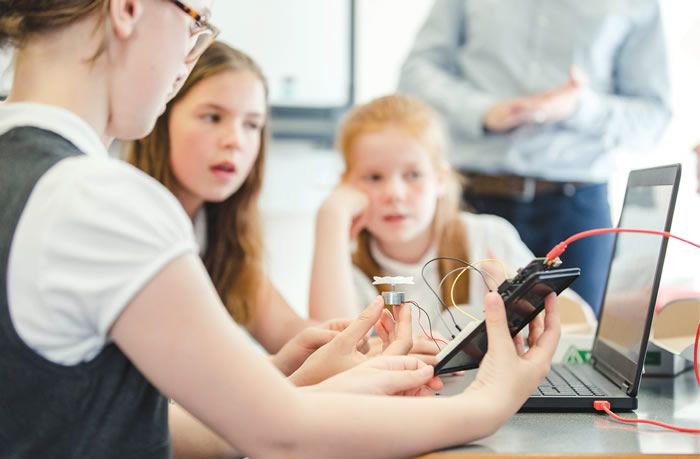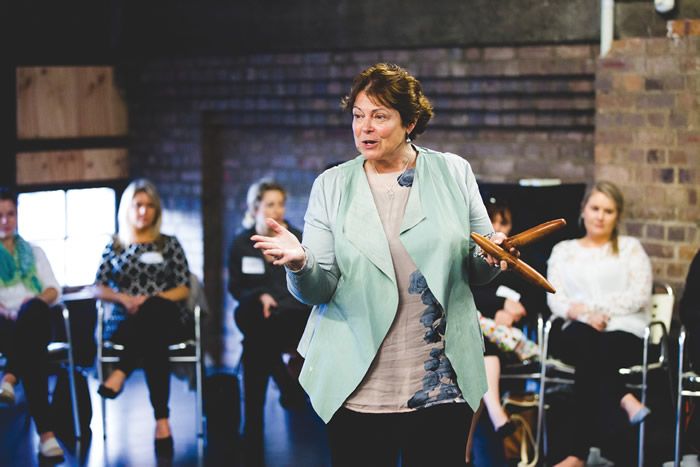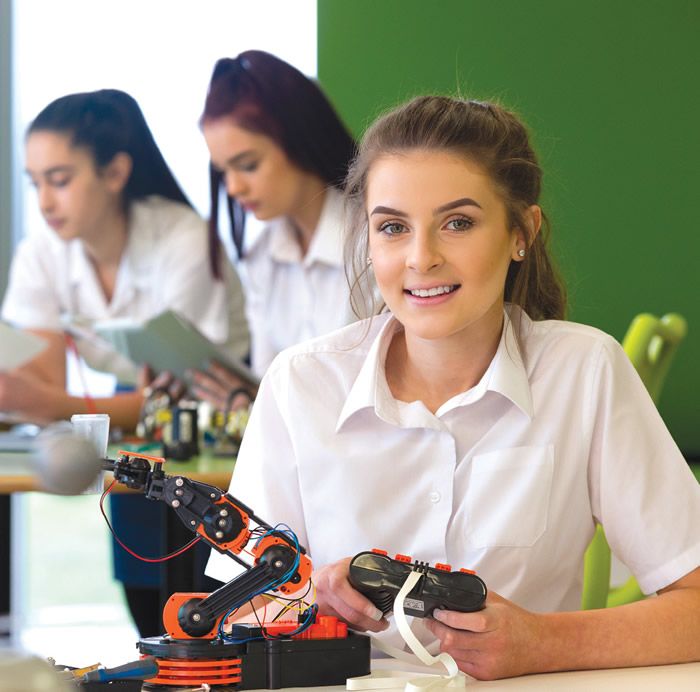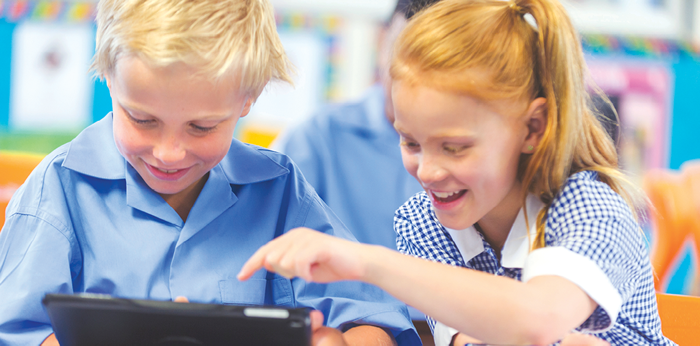Malpass too emphasises the crucial relationship of teacher and student. “We should guard against the risk of losing focus on the essential qualities of a great classroom (whatever the century), and the core dynamic between a fine teacher and his or her students,” he wrote.
Meaningful communication
This vital dynamic between teacher and pupil, and even parent and child, is what Professor Ewing calls “meaningful communication” – and it is central to all learning. And learning to read, she says, is all about “meaning making”.
She also issues a wake-up call: children who are “babysat” by screens from a very early age start school with thousands fewer words in their vocabularies than children who have experienced meaningful communication.
“There are different kinds of online learning – some are interactive, some are passive, they are about sitting and listening, and there’s a time for that,” Professor Ewing said. “But there has to be time to ask questions, and to ask the big questions, not just the kind that get an instant answer. And there has to be a time for wondering, and talking about the questions for which there aren’t clear-cut answers.” Children absolutely need these “substantive conversations“ with teachers, parents and peers.
Professor Ewing emphasises the issue is not the technology itself, but how it is used. It is one thing for a student to spend several hours online researching and exchanging ideas with classmates, another altogether to spend it scrolling aimlessly through social media.
Smith also worries about parents avoiding meaningful conversations with their children, citing young parents in the local park who focus on their phones while their children play, and prams with brackets to hold iPads to keep toddlers, even babies, entertained. Professor Ewing recommends children under the age of one not have any screen time at all.
Fatigued and frustrated
Jones is keenly aware of tiredness among his tech-loving pupils who play online games late into the night. “It’s a really big issue with teenage boys of 15-plus,” he said. “It’s not confined to my school, but there are a number of students who struggle to complete homework – they’re tired during class time, and when I ask why, it’s because they’re playing games.”
A teacher who responded to the Growing up Digital survey expressed a different but no less disquieting concern about computer games: “Students seem to spend a large portion of the day thinking about the games they play at home during their classroom learning time, which impacts the focus they have on their learning.”
Smith notes that her kindergartners become frustrated if they cannot solve a technical issue instantly, and they quickly lose patience with login processes. “Their mood changes if they can’t do something or they don’t understand why it’s not working,” she said. Similarly, she says, teachers become frustrated when the internet is down, interrupting their lessons.
Empathy and the arts
Professor Ewing was not surprised to discover that 78 per cent of the respondents to the Growing up Digital survey noticed a decline in empathy among students.
As an antidote, she emphasises the role of literature and the creative arts in developing empathy. “We’ve got a lot of research now to show that the reading of imaginative fiction or story – you know, books – is really important for us in continuing to develop our empathy and compassion,” she said. “The more opportunities there are to focus on the imaginative and the fictional, the more that helps us understand ourselves as human beings and understand others.
“The more we can use art forms like drama and art and music and dance, which are all literacies in different ways, because they’re all about making meaning in different ways, the more we will be able to imagine different possibilities and different ways of making the world a better and more socially just place,” she said.
Professor Ewing is nonetheless aware that in the face of an online world that serves up constant colour and movement and novelty, engaging students in artistic processes is not necessarily easy. But she is optimistic. “All of us innately need the arts,” she said. “Slowing things down is important. It’s about less is more and about enabling us to use arts processes and experiences to look at the things we take for granted in the world in a different way. It’s not about the end product but the process.”
Jones says he is yet to meet a student who isn’t captivated by The Outsiders, the coming-of-age novel by S E Hinton, published in 1967. And he has paved a way into Shakespeare for his students through Pop Sonnets, in which author Erik Didriksen rewrites lyrics by the likes of Beyoncé, the Beatles, Taylor Swift and Queen in the style of Shakespearean sonnets. Initially released on Instagram, Pop Sonnets are a unique melding of Elizabethan literature and the digital age. They engender intense focus among Jones’s students, who compete to identify each song while simultaneously absorbing an important literary genre.
The results of this kind of learning are unequivocal, Professor Ewing says: students who are engaged in arts-rich processes get their social and emotional wellbeing fed, which in turn means they fare better academically – and not just in arts subjects, but in non-arts areas as well.
And once students gain vital critical thinking and literacy skills, she says, they can more effectively evaluate what they encounter on the internet. It follows that they are less likely to fall victim to the kinds of scams, conspiracy theories and “fake news” that have become increasingly prevalent online in the past five years.
Budget blues
While Smith is squarely among those who see technology as enhancing learning and teaching, she nonetheless worries about the financial pressure on both schools and parents. “Technology is changing all the time, and each time it becomes more expensive,” she said. Then there are the frustrating compatibility issues between the devices and operating systems used in the classroom and those the students have at home.
Some 83 per cent of teachers who responded to the Growing up Digital survey agree that socio-economic circumstances impact on access to educational technology. This was thrown into sharp relief during the recent shift to online learning as a result of the coronavirus. A family with three or four children, for example, cannot necessarily provide a laptop and/or iPad for each one.
The Growing up Digital report revealed another unsettling statistic. “Worryingly, 29 per cent of teachers have noticed an increase in the number of students coming to school hungry,” it said. “It is possible this could be an indicator of growing financial strain on families, perhaps in an effort to keep in step with the technological advances and expense of devices.”
Igniting interest
Through all this technological transformation and the reach of technology into the nation’s classrooms, two factors emerge as timeless. The first is the relationship between teacher and student that cannot be replicated by any technology.
Jones raises the quote often attributed to Irish poet W B Yeats: “Education is not the filling of a pail, but the lighting of a fire.” It is the role of the teacher, not technology, to ignite that fire. “If you can stimulate the curiosity of students, they will start to learn and teach themselves,” Jones said. “And I think that might be where the most productive learning is done, when it’s self-directed.”
The second is the importance of good old-fashioned books in the teaching and gaining of literacy. A self-described eBooks addict, Smith nonetheless believes in very young children experiencing books. “Don’t shove that thing in their faces!” she wants to say to parents who absent-mindedly hand devices to their children. “You’ve got to give them books and the experience of turning pages.”
Professor Ewing couldn’t agree more. “That’s one of the key indicators and key predictors of success: the amount of reading and the number of books in the home,” she said.









































































































































